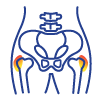
Hip Bursitis
What is Hip Bursitis?
The sacs of fluid between the bones and soft tissues in the hip joint are called bursae. Bursae minimise friction of the hip bones, allowing a much greater range of motion. Damage to the bursae can prevent the hip from functioning properly. Hip bursitis is an inflammation of the bursae around the hip.
What are the Symptoms of Hip Bursitis?
The most common symptoms of hip bursitis are:
- Pain or ache in the hip.
- Inability to sit or lie down on the affected hip.
- Difficulty standing from a sitting position.
What are the Causes of Hip Bursitis?
Hip bursitis is most often caused by prolonged stress or overuse of the hip joint. It is particularly common amongst runners.
Other causes of bursitis include:
- Previous hip surgery.
- A major difference in the leg length.
- Spinal disorders
- Rheumatoid arthritis
- Bony spurs
How is Hip Bursitis Treated?
Treatments is usually conservative, including:
- Cold compresses.
- Physicotherapy.
- Anti-inflammatory medications.
- Corticosteroid injections into the bursa.
Most patients with hip bursitis respond well to conservative treatment, however severe cases may benefit from surgery. With surgery, your surgeon will fluid from the inflamed bursa or, if necessary, excise the inflamed bursa itself. In most cases, surgery is performed arthroscopically.
As a minimally invasive procedure, bursa excision is designed to reduce the risk of complications and speed recovery. You will walk on crutches for a few days after surgery, and may need to wear a supportive brace.
Within two weeks, most patients can begin physiotherapy. You can expect a complete recovery after 2-3 months of rehabilitation.


